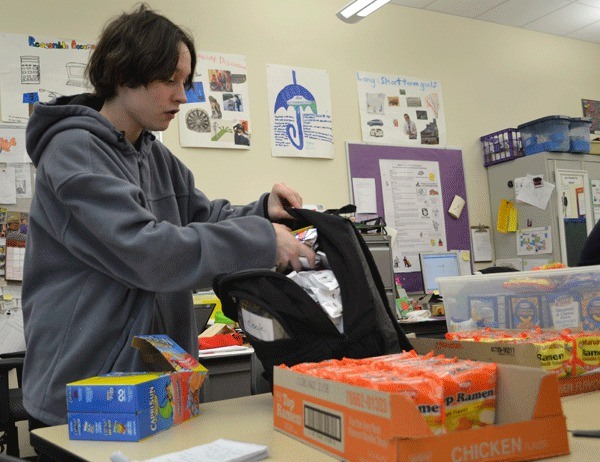Even when temperatures dipped during the second week of December, the chill didn’t deter students from their prime directive.
“It was really cold,” student Diamond Antoniou said.
“My fingers were purple.”
For the past two months, Oak Harbor High School Transition students collected food outside Alberstons and Saar’s Market Place Foods. The food will go to Back Packs for Hunger, a service project they started at the beginning of the school year.
“We started it because kids didn’t have food at their place,” Antoniou said.
During that cold week, one of the donators gave the students hand-warmers so they be more comfortable while enduring frigid temperatures.
“It made my hands nice and warm,” Antoniou said.
From noon to 1 p.m. each Monday, the students hand a list to customers entering the stores with items they need.
The sheets they were handing out had “peanut butter” and “jelly” highlighted, since they didn’t have a lot back in the classroom. They had more than enough Top Ramen and macaroni and cheese stored in their classroom.
As the students strategically positioned themselves to intercept the most people entering the store, they still communicated and encouraged one other.
“Diamond, here comes somebody,” student Rachel Miller would say, as someone would walk to Antonious’s side.
Miller said it’s hard to talk to strangers, but it feels good once its over, especially if it results in a contribution.
“The first week (we were out here) we got a lot,” Miller said.
The most food the group has collected in one hour was three full tubs. They faired well on this trip, filling one tote full of food to stuff backpacks with later in the week.
The students won’t be out during their vacation from school, but Miller said they’ll be back at it once school starts again.
Transition class is for 18- to 21-year-old students who received special education services and are learning how to be independent adults working, living and recreating in the community, said Diane Fesler-Macaluso, Transition coordinator.
The students brainstormed service project ideas and came up with providing backpacks filled with food for students at Broad View Elementary. Currently they are filling backpacks for five students to take home so they have enough food to eat over the weekend.
Fesler-Macaluso said her students were responsible for all phases of the project. From requesting businesses’ permission to collect outside their store fronts, to picking the elementary school to help — this has been their own project.
“It is great initiative on their parts,” said Janet Tagge, Broad View Elementary School counselor.
Tagge receives the backpacks and then makes sure they go to students who need them.
Since the elementary school is close to the high school, it makes it easy for dropping off and picking up the backpacks.
“Other schools would love to have this program,” Tagge said.
The project also helps the students get out and talk to people, said Linda Lee, a paraeducator for Transition.
Donators sometimes leave items at the customer service counters for the students to pick-up, Lee said.
The businesses are great partners and supportive of the project.
After collecting food, students packed the bags. Student Narrisa Backman helped other students efficiently pack. She said they needed to cram two weeks worth of food instead of one since schools would be on break. She went around with other students lifting the packs to make sure they weren’t too heavy for the elementary students to carry home.
In addition to volunteering for their own service project, the students work at an array businesses and nonprofits around town to improve their work skills. Some of the businesses and organizations include Salon 7, Wind and Tide Book Shop, Whidbey Animal Improvement Foundation and Hand-in-Hand Learning Center.
“We find places that are a good fit,” Fesler-Macaluso said.
To begin, the students have job coaches to help learn the ropes until an employer is comfortable with them working on their own. Then the teachers hold monthly evaluations to see how the student is doing.
“It’s a scaffolding technique,” Fesler-Macaluso said.
The goal is to keep building their skill set, Fesler-Macaluso said.
Each student has goals for what they want to do when they are finished with Transitions.
Antoniou wants to become a game programmer.



